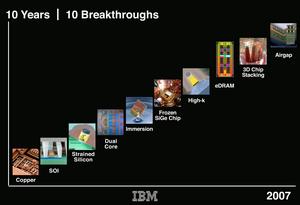|
|
ARMONK, NY -- (MARKET WIRE) -- May 03, 2007 -- Today's announcement by IBM (NYSE: [url=http://studio.financialcontent.com/Engine?Account=iwire& ageName=QUOTE&Ticker=IBM]IBM[/url]) of a major breakthrough in chip design -- called \"airgap\" -- bookends a decade of innovation from IBM Labs that have transformed the IT industry with new materials and design architectures to build smaller, more powerful and energy efficient chips. ageName=QUOTE&Ticker=IBM]IBM[/url]) of a major breakthrough in chip design -- called \"airgap\" -- bookends a decade of innovation from IBM Labs that have transformed the IT industry with new materials and design architectures to build smaller, more powerful and energy efficient chips.
IBM's pioneering work to move the industry from aluminum to copper wiring, unveiled in 1997, gave the industry an immediate 35 percent reduction in electron flow resistance and a 15 percent boost in chip performance.
Since then, IBM scientists have continued to drive performance improvements to continue the path of Moore's Law. Ten of IBM's biggest chip breakthroughs chosen from the dozens of innovations coming from IBM's labs in the past ten years include:
 (Click here for details)
(Click here for details)
10 IBM Breakthroughs in 10 Years -- Beginning with the
use of copper for chip wiring, IBM has announced 10
semiconductor innovations over the course of 10
years that have enabled computers and many other kinds
of electronic devices to become smaller, less expensive,
more powerful, and more energy efficient. IBM today announced
it has harnessed the natural tendency of materials to form
patterns to create a vacuum between the miles of wires inside
chips. This provides better insulation speeding performance
and reducing power consumption.
2. SOI (August 1998) -- Silicon on Insulator technology reduces power consumption and increases performance by helping insulate the millions of transistors on modern chips. The industry had been working on this technology for 15 years before IBM made it happen.
3. Strained Silicon (June 2001) -- This technology stretches the material inside chips, decreasing the resistance and speeding the flow of electrons through transistors to increase performance and decrease power consumption.
4. Dual-Core Microprocessors (October 2001) -- POWER4, the world's first dual-core microprocessor, was announced as part of Regatta, a System p server and the world's most powerful. More than two years would pass -- an eternity in the technology business -- before our first competitors brought a dual-core chip to market.
5. Immersion Lithography (December 2004) -- IBM announces it is the first company in the world to use this new manufacturing technology -- a method to build chips with ever smaller features -- to produce commercial microprocessors.
6. Frozen SiGe Chip (June 2006) -- In the 1990s, IBM first uses Silicon Germanium to replace more expensive and exotic materials, leading to smaller, faster and lower cost chips, and pushing IBM into the business of selling chips to companies for wireless products, such as mobile phones and routers. Last year, IBM pushed the limits of its SiGe technology again when it teamed with Georgia Tech -- with support from NASA -- to demonstrate the first silicon-based chip capable of operating at frequencies above 500GHz, by \"freezing\" the chip to near absolute zero.
7. High-k (January 2007) -- IBM announces a solution to one of the industry's most vexing problems -- transistors that leak current. By using new materials IBM will create chips with \"high-k metal gates\" that will enable products with better performance that are both smaller and more power efficient.
8. eDRAM (February 2007) -- By replacing SRAM with an innovative new type of speedy DRAM on a microprocessor chip, IBM will be able to more than triple the amount of embedded memory and boost performance significantly.
9. 3-D Chip Stacking (April 2007) -- IBM announces the creation of three-dimensional chips using \"through-silicon vias,\" allowing semiconductors to be stacked vertically instead of being placed near each other horizontally. This cuts the length of critical circuit pathways by up to 1,000 times.
10. Airgap (May 2007) -- Using a \"self assembly\" nanotechnology IBM has created a vacuum between the miles of wire inside a Power Architecture microprocessor reducing unwanted capacitance and improving both performance and power efficiency.
Note to Editors:
Broadcast-quality video on airgap can be downloaded by journalists at: http://www.thenewsmarket.com/ibm.
Photos and related materials are available in the IBM Press Room at: http://www-03.ibm.com/press/us/en/presskit/21463.wss.
For further information about IBM Microelectronics, visit http://www.ibm.com/chips/
For more information about IBM Research, visit http://www.ibm.com/research |
|